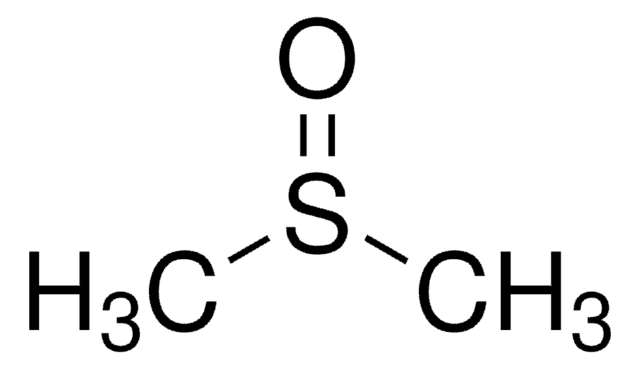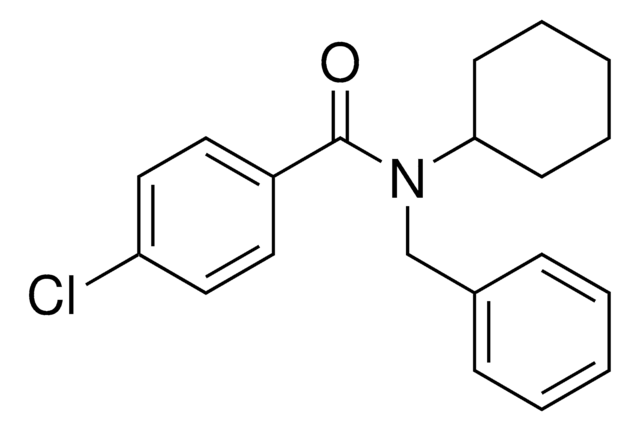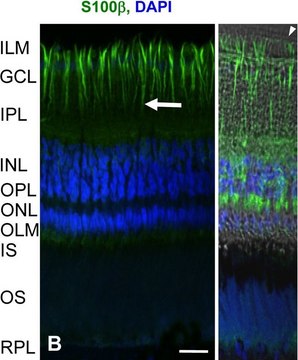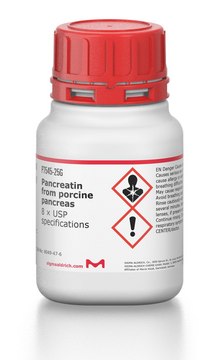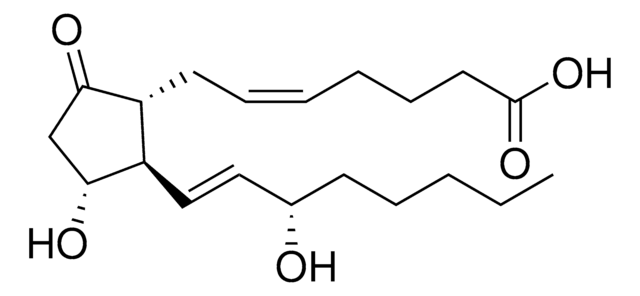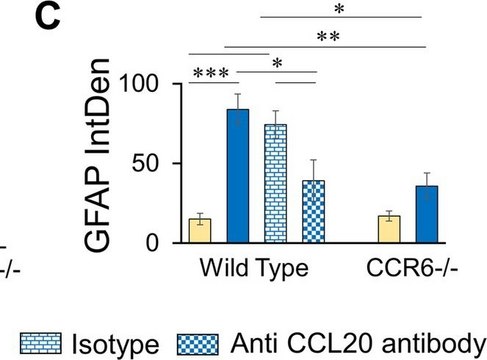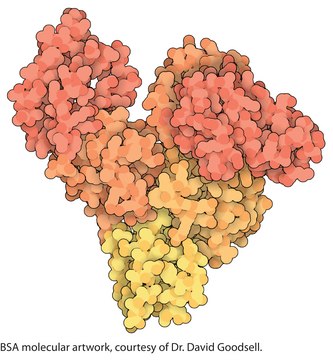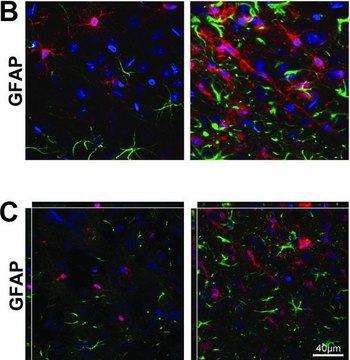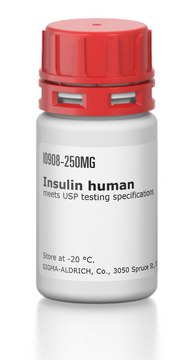Recommended Products
Assay
≥95% (SDS-PAGE)
Quality Level
form
lyophilized
manufacturer/tradename
Calbiochem®
storage condition
OK to freeze
impurities
≤10% S100 α-chain (Western blot)
solubility
50 mM Tris buffer, pH 8.0: 5 mg/mL
shipped in
ambient
storage temp.
−20°C
General description
Research area: NEUROSCIENCE
Native homodimeric S-100b isoform composed of ββ-subunits, purified from bovine brain. The S100 calcium-binding protein B (S100B) exists in the form of homo- or hetero-dimers comprised of two subunits, A and B. Specifically, the S-100AB and S-100BB types are referred to as S100B protein and are known for their strong association with nervous tissue. This protein can be found in the cytosol of glial and Schwann cells. The gene responsible for encoding the S100B protein is situated in the chromosomal region 21q22. Under nonreducing conditions both the dimeric and monomeric forms may be visible.
Native homodimeric S-100b isoform composed of ββ-subunits, purified from bovine brain. The S100 calcium-binding protein B (S100B) exists in the form of homo- or hetero-dimers comprised of two subunits, A and B. Specifically, the S-100AB and S-100BB types are referred to as S100B protein and are known for their strong association with nervous tissue. This protein can be found in the cytosol of glial and Schwann cells. The gene responsible for encoding the S100B protein is situated in the chromosomal region 21q22. Under nonreducing conditions both the dimeric and monomeric forms may be visible.
Application
S100 calcium-binding protein B (S100B) has been used:
- to study the interaction between the serotonin 5-HT7 receptor and the calcium-binding protein S100B using surface plasmon resonance-based method.
- as a probe to detect and study the binding interactions with proteins during the far-western blotting technique.
- to investigate the role of S100B in relation to blood-brain barrier (BBB) integrity and its potential involvement in the production of autoantibodies against S100B.
- to study the mechanism of communication between thermogenic adipocytes and sympathetic neurons mediated by Calsyntenin-3β and S100b, providing insights into the regulation of sympathetic innervation in adipose tissue.
Biochem/physiol Actions
The S100 calcium-binding protein B (S100B) is known to interact with the cytoskeleton and plays crucial roles in cell proliferation, survival, regulation of calcium homeostasis, and enzyme activities. S100B has been observed to have several effects, including up-regulating the expression of inducible NOS, inducing the release of nitric oxide (NO) in astrocytes and microglia, up-regulating cyclooxygenase-2 expression in microglia and monocytes, triggering NO-dependent death of astrocytes and neurons, increasing the production of reactive oxygen species in neurons, and causing disruption of lipid homeostasis and cell cycle arrest. Elevated levels of S100B have also been observed in the CSF of patients with brain tumors, as well as in the blood of patients with Alzheimer′s disease and Parkinson′s disease. Elevated serum level of S-100b is used as a marker of stroke and cerebral edema. The S-100 proteins are acidic Ca2+ binding proteins found predominately in glial cells. Evidence indicates that upon binding to Ca2+, S-100 proteins expose a hydrophobic domain to the solvent in a manner similar to calmodulin. Within the cell, S-100 proteins have been reported to regulate adenylate cyclase, aldolase activities, ATPase, microtubules, and protein phosphorylation.
Warning
Toxicity: Standard Handling (A)
Physical form
Lyophilized from 50 mM Tris-HCl, pH 7.5, 50 mM NaCl, 100 µM DTT.
Reconstitution
Following reconstitution, aliquot and freeze (-20°C). Stock solutions are stable for up to 6 months at -20°C.
Other Notes
Momotani, E., et al. 1993. J. Comp. Pathol. 108, 291.
Baudier, J., et al. 1992. Proc. Natl. Acad. Sci. USA 89, 11627.
Donato, R. 1991. Cell Calcium12, 713.
Isobe, T., et al. 1977. Biochim. Biophys. Acta494, 222.
Baudier, J., et al. 1992. Proc. Natl. Acad. Sci. USA 89, 11627.
Donato, R. 1991. Cell Calcium12, 713.
Isobe, T., et al. 1977. Biochim. Biophys. Acta494, 222.
Legal Information
CALBIOCHEM is a registered trademark of Merck KGaA, Darmstadt, Germany
Storage Class Code
11 - Combustible Solids
WGK
WGK 1
Flash Point(F)
Not applicable
Flash Point(C)
Not applicable
Certificates of Analysis (COA)
Search for Certificates of Analysis (COA) by entering the products Lot/Batch Number. Lot and Batch Numbers can be found on a product’s label following the words ‘Lot’ or ‘Batch’.
Already Own This Product?
Find documentation for the products that you have recently purchased in the Document Library.
Xing Zeng et al.
Nature, 569(7755), 229-235 (2019-05-03)
The sympathetic nervous system drives brown and beige adipocyte thermogenesis through the release of noradrenaline from local axons. However, the molecular basis of higher levels of sympathetic innervation of thermogenic fat, compared to white fat, has remained unknown. Here we
The S100B protein in biological fluids: more than a lifelong biomarker of brain distress
Michetti F, et al.
Journal of Neurochemistry (2011)
Nirakar Sahoo et al.
FEBS letters, 584(18), 3896-3900 (2010-08-17)
Voltage-dependent human ether à go-go (hEAG1) potassium channels are implicated in neuronal signaling as well as in cancer cell proliferation. Unique sensitivity of the channel to intracellular Ca(2+) is mediated by calmodulin (CaM) binding to the intracellular N- and C-termini
CD166/ALCAM mediates proinflammatory effects of S100B in delayed type hypersensitivity
Rudiger von Bauer
Journal of Immunology, 191(1), 369-377 (2013)
Rüdiger von Bauer et al.
Journal of immunology (Baltimore, Md. : 1950), 191(1), 369-377 (2013-06-05)
Promiscuity of pattern recognition receptors, such as receptor for advanced glycation end products (RAGE), allows for a complex regulatory network controlling inflammation. Scavenging of RAGE ligands by soluble RAGE treatment is effective in reducing delayed-type hypersensitivity (DTH), even in RAGE(-/-)
Our team of scientists has experience in all areas of research including Life Science, Material Science, Chemical Synthesis, Chromatography, Analytical and many others.
Contact Technical Service